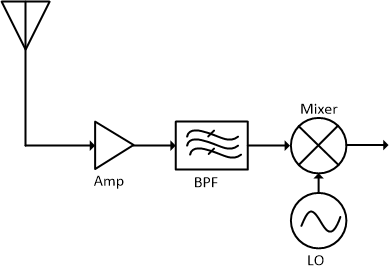SNAA342 September 2020 LMX2820
1 Overview of Frequency Hopping
The ability to quickly switch between multiple frequencies, also known as frequency hopping, is a critical element in many systems, such as communications, defense radio, and electronic warfare. For these applications, it is imperative that switching between frequencies happens as quickly as possible.
For example, the Link-16 network used by NATO for transferring real-time tactical information requires frequency hopping under 13 μs.[1] [2]
Figure 1-1 illustrates the typical receiver architecture that requires one or more local oscillators (LOs) to generate the different frequency signals and mix them with an incoming receive signal.
 Figure 1-1 Typical Receiver
Architecture
Figure 1-1 Typical Receiver
ArchitectureIn such an architecture, the LMX2820 device can be used as an LO and simplifies the design with two key features: (1) integrating multiple VCO cores into one chip and (2) having ultra-fast VCO calibration. The eight VCO cores in the LMX2820 allow for wideband frequency coverage from 43.75 MHz to 22.4 GHz from a single IC, removing the need for multiple LOs. To switch quickly between these VCO cores, the Instant Calibration function of the LMX2820 device greatly reduces VCO calibration time to less than 5 µs, thus reducing the overall lock time.
This report gives an example of achieving a lock time of under 11 μs with the LMX2820. When compared with other calibration methods available today, it is clear that Instant Calibration provides the fastest solution for designing frequency hopping systems.